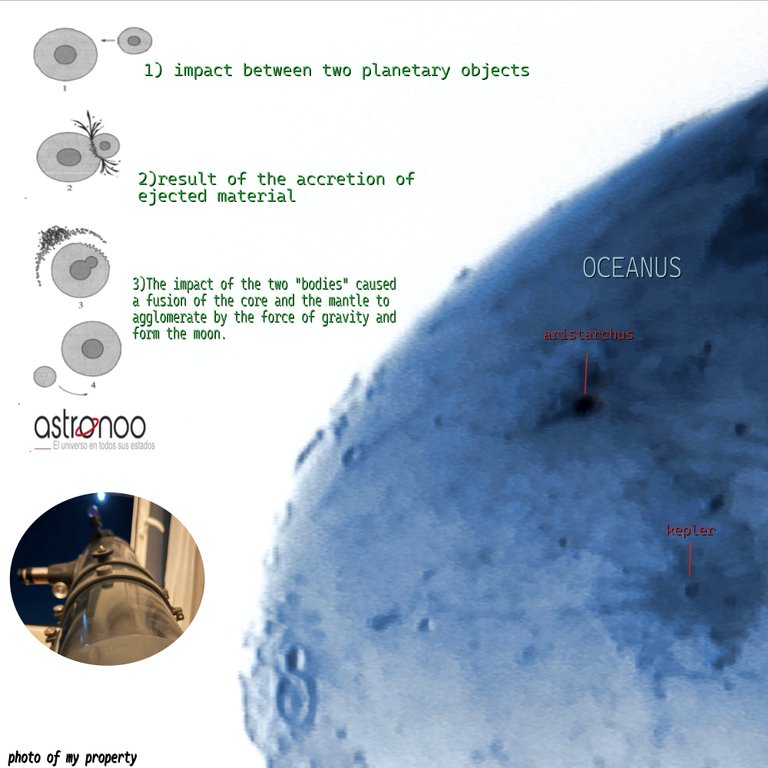Hello science-loving friends, while I was using my Astromaster to see details of the moon and learn something new, I managed to photograph some small craters that I had never seen before and I decided to look up their names on the internet until I found an article on the "astronoo" website that explained in great detail how the moon was created; and in principle it all had to do with the impact of "two large planets" and we can see this in great detail on the moon, so I decided to create a small post to understand how the moon was formed in space.🔭🪐
Hola amigos amantes de la ciencia, mientras usaba mi Astromaster para ver detalles de la luna y aprender algo nuevo, consegui fotografiar unos pequenos crateres que nunca habia visto y decidi buscar sus nombres en internet hasta llegar a un articulo de la pagina "astronoo" la cual explicaba con muchos detalles como fue que se creo la luna; y en principio todo tuvo que ver con el impacto de "dos grandes planetas" y esto lo podemos ver con mucho detalle en la luna, por lo que decidi crear un pequeno post para entender como fue que se formo la luna en el espacio.🌌🌔

Origin of the moon🪐🔭/Origen de la luna🌌🌔

There is not only one moon in the entire solar system, on the contrary the "moon" is called all the satellites that have a planet, our only natural satellite is approximately 384 thousand kilometers from the earth, the dark side of the moon is impossible to see therefore we do not have records with a telescope, the details of that side of the moon we can see thanks to the probes and images published by NASA. THERE IS NO THEORY THAT DETERMINES THE ORIGIN OF THE MOON, it is currently under debate however the most accepted theory believes that the material observed on the moon is the result of a large impact between two mantles of possibly two "young earths". Possibly this impact occurred more than 4.5 billion years ago, when we see the craters of the moon we can imagine a little what that collision between the young planets could have been like.🔭🌌
No existe una sola luna en todo el sistema solar, por el contrario la "luna" se le llama a todos los satelites que tienen un planeta, nuestro unico satelite natural esta aproximadamente a 384mil kilometros de la tierra, el lado oscuro de la luna es imposible verlo por tanto nosotros no tenemos registros con un telescopio, los detalles de ese lado de la luna lo podemos ver gracias a las sondas e imagines que publica la NASA. NO EXISTE UNA TEORIA QUE DETERMINE EL ORIGEN DE LA LUNA, actualmente esta en debate sin embargo la teoria mas aceptada cree que el material que se observa en la luna es resultado de un gran impacto entre dos mantos de posiblemente dos "tierras jovenes". Posiblemente este impacto ocurrio hace mas de 4500 millones de anos, cuando vemos los crateres de la luna podemos imaginarnos un poco como pudo haber sido esa colision entre los planetes jovenes.🌔🪐
https://astronoo.com/es/articulos/crateres-de-la-luna.html


I think the author of this post explains quite well how the moon was formed, if you look at the image on the left you can see how two giant bodies "which are the young planets" impacted each other, in the center we see that darker circle which is the metal or iron core, and curiously the center of the earth has a high concentration of "iron and nickel" that is proof of why scientists believe that the moon was formed by the impact of two nuclei, after the impact the nuclei fuse and the rest of the material is released into space and there the gravitational force acts that brought that material together and formed the satellite. Here I show you two of the deepest impacts on the moon, these are "Aristarchus and Kepler" which, unlike other impacts, left a mark in the form of "striations" that makes us think about the force with which they hit the moon (the photos of the moon were taken at a magnification of 256x using filters).🌔🌌.
Creo que el autor de esta publicacion explica bastante bien como fue que la luna se formo, si ves en la imagen izquierda podremos notar como dos cuerpos gigantes "los cuales son los planetas jovenes" impactaron uno con el otro, en el centro vemos ese circulo mas oscuro que es el nucleo de metal o hierro, y curiosamente el centro de la tierra tiene una alta concentracion de "hierro y niquel" esa es la prueba del porque los cientificos creen que la luna tuvo una formacion por el impacto de dos nucleos, luego del impacto los nucleos se fusionan y el resto de material se desprende al espacio y alli actua la fuerza gravitacional que junto ese material y formo el satelite. Aqui te muestro dos de los impactos mas profundos en la luna se trata de "aristarchus y kepler" que a diferencia de otros impactos estos dejaron una marca en forma de "estrias" que nos hace pensar con la fuerza que golpearon la luna (las fotos de la luna las tome a un amumento de 256x con utilizacion de filtros)🔭🌍
https://astronoo.com/es/articulos/crateres-de-la-luna.html

Does the moon have water?🪐🔭/Si tiene agua la luna?🌌🌔

I have never read about the subject of water on the moon because until many years ago it was thought that the moon did not have water in any of its states of matter... But... It is now scientifically proven that the moon has water but at a very low latitude, in 2009 an article was published that states: "the moon has half a liter of water per hectare". But where do these data come from? Well, from the use of infrared by means of probes on the moon, as we see in the upper left photo; gathering all this information we can think that in the craters of the moon at the bottom there is stored water, in reality in the south pole of the moon there is frozen water.🔭🌌
Nunca lei sobre el tema del agua en la luna porque hasta hace muchos anos se pensaba que la luna no tenia agua en ninguno de sus estados de la materia... Pero... Ya esta cientificamente comprobado que la luna tiene agua pero en una latitud muy baja, en el 2009 se publico un articulo que expresa: "la luna tiene medio litro de agua por cada hectarea". Pero de donde se sacan estos datos? pues de la utilizacion de infrarojos por medio de las sondas a la luna, tal como vemos en la foto superior izquierda; reuniendo toda esta informacion podemos pensar que en los crateres de la luna en el fondo hay agua almacenada, en realidad en el polo sur de la luna hay agua congelada. 🌔🪐
https://astronoo.com/es/luna.html


Little is said about the mountains that the moon has, and we see next to the crater "Eralosthenes" the "Apennines" is a mountain range that has more than three thousand mountains, it extends more than 400 miles, within the mountain range there are some mountains that are more than 18 thousand feet high (
https://the-moon.us/wiki/Apennine_Mts); About the crater "Eratosthenes" it is quite studied because it is a perfect circumference that in the center has some mountains has a diameter of 59km and a depth of 3.6km according to the calculations of astronomers this crater was formed when an object impacted the moon more than 3.2 billion years ago (
https://es.wikipedia.org/wiki/Eratosthenes_(cr%C3%A1ter)⛰️🌌
Poco se habla de los montes que tiene la luna, y es que vemos al lado del crater "eralostenes" los "Apeninos" es una coordillera que tiene mas de tres mil montanas, se extiende a mas de 400 millas, dentro de la coordillera hay algunas montanas que tienen mas de 18mil pies de altura ; sobre el crater "Eratosthenes" es bastante estudiado porque es una circuferencia perfecta que en el centro tiene unas montanas tiene un diametro de 59km y una profundidad de 3,6km segundo los calculos de los astronomos este crater se formo cuando un objeto impacto la luna hace mas de 3200 millones de anos🌍🪐


este articulo nos dice que podemos comprobar desde la tierra con una fotografia muy buena que el hombre piso la luna... como es posible? pues hay registros de dos paneles solares dejados por la mision apollo 11 y que reflejan luz si usamos filtros, segun la ubicacion y el tipo de luz si no me equivoco e fotografiado dos de ellos o quizas uno.🔭🌔


DNA is an organization to foster and DENSIFY NATURE-APPRECIATION which aims to establish REPORTS OF BIODIVERSITY DATA that is contributed by all of us Hiveans and subsequently cataloged.
Therefore DNA searches for HIGH-QUALITY posts that aim to DESCRIBE and determine the BIODIVERSITY AROUND YOU with added EXPLANATIONS and INFORMATION. For these informative posts they offer a CURATION SERVICE using the @dna.org account. It is also a CURATION TRAIL. Just add the #dna TAG if you think that any of your posts is what they are looking for.
THANKS FOR READING ME (PHOTOS AND VIDEOS OF MY PROPERTY) / GRACIAS POR LEERME FOTOS Y VIDEOS DE MI PROPIEDAD🙂🧠🦾👍
This post was inspired and made thanks to the article published on the "astronoo" page, so I must thank you for your publication and give credit to the information I took from there. The photos of the moon are my property.🔭😀












Thanks for your contribution to the STEMsocial community. Feel free to join us on discord to get to know the rest of us!
Please consider delegating to the @stemsocial account (85% of the curation rewards are returned).
You may also include @stemsocial as a beneficiary of the rewards of this post to get a stronger support.
¡Felicitaciones!
Estás participando para optar a la mención especial que se efectuará el domingo 17 de noviembre del 2024 a las 8:00 pm (hora de Venezuela), gracias a la cual el autor del artículo seleccionado recibirá la cantidad de 1 HIVE transferida a su cuenta.
¡También has recibido 1 ENTROKEN! El token del PROYECTO ENTROPÍA impulsado por la plataforma Steem-Engine.
1. Invierte en el PROYECTO ENTROPÍA y recibe ganancias semanalmente. Entra aquí para más información.
2. Contáctanos en Discord: https://discord.gg/hkCjFeb
3. Suscríbete a nuestra COMUNIDAD y apoya al trail de @Entropia y así podrás ganar recompensas de curación de forma automática. Entra aquí para más información sobre nuestro trail.
4. Visita nuestro canal de Youtube.
Atentamente
El equipo de curación del PROYECTO ENTROPÍA